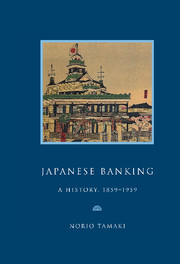Book contents
- Frontmatter
- Contents
- Preface
- Genealogy of leading Japanese banks, 1859–1959
- List of abbreviations
- Map
- Part I A bankrupt Shogunate, 1859–1868
- Part II The Meiji Restoration: monetary confusion and banking experiments, 1868–1881
- Historical background
- 5 The first banking experiment, 1868–1872
- 6 The national bank system: the American influence, 1870–1881
- 7 The origins of ordinary banking: another bank mania, 1875–1881
- 8 The search for stability: the last bank controversy, 1879–1881
- Part III Matsukata, the wizard of Japanese banking, 1881–1897; the Yokohama Specie Bank (1880) and the Bank of Japan (1882)
- Part IV The Japanese on the London money market, 1897–1911
- Part V War, the Japanese boom years, 1911–1919
- Part VI Crisis and the road to war, 1919–1937
- Part VII Complete commitment, struggle and defeat, 1937–1945
- Part VIII American ‘democratisation’ and the search for growth, 1945–1959
- An extraordinary century, 1859–1959
- Appendices
- Notes
- Bibliography
- Index
Historical background
Published online by Cambridge University Press: 03 February 2010
- Frontmatter
- Contents
- Preface
- Genealogy of leading Japanese banks, 1859–1959
- List of abbreviations
- Map
- Part I A bankrupt Shogunate, 1859–1868
- Part II The Meiji Restoration: monetary confusion and banking experiments, 1868–1881
- Historical background
- 5 The first banking experiment, 1868–1872
- 6 The national bank system: the American influence, 1870–1881
- 7 The origins of ordinary banking: another bank mania, 1875–1881
- 8 The search for stability: the last bank controversy, 1879–1881
- Part III Matsukata, the wizard of Japanese banking, 1881–1897; the Yokohama Specie Bank (1880) and the Bank of Japan (1882)
- Part IV The Japanese on the London money market, 1897–1911
- Part V War, the Japanese boom years, 1911–1919
- Part VI Crisis and the road to war, 1919–1937
- Part VII Complete commitment, struggle and defeat, 1937–1945
- Part VIII American ‘democratisation’ and the search for growth, 1945–1959
- An extraordinary century, 1859–1959
- Appendices
- Notes
- Bibliography
- Index
Summary
Restoration government troops finally, in July 1868, swept away the remnants of the bakufu. Edo was renamed Tokyo, becoming the new eastern capital, and the Japanese name for the era was changed from Keio to Meiji, or ‘Enlightenment’, in the autumn of 1868. Following the example of the Taika Restoration in 645, lands and people heretofore ruled separately by nearly 250 daimyo under the Shogunate were returned to the Emperor in 1869. The huge change started a kind of political Darwinism. Qualification for survival was without doubt an understanding of western experiences enabling one to comprehend the exact position of Japan in the world and her most urgent needs. In 1871, after the return of a small delegation to America, the abolition of han was carried out, and former daimyo were denied an active part in politics. In 1873, the return of the Iwakura Mission from their long western tour resulted in the exclusion from power of those who wished to wage war on Korea. The most prominent of the dissentients was Takamori Saigo, who had been supreme commander of the restoration army but who had no western experiences. There followed a series of uprisings of former samurai dissentients culminating in the Satsuma Rebellion of 1877 led by Saigo. Even after, power struggles continued and in 1881 Shigenobu Okuma was ousted from government. Okuma had tried various financial experiments which, despite his courage and enterprise, had been disastrous for Japan. He was outclassed by Masayoshi Matsukata whose mind was filled with western ideas.
- Type
- Chapter
- Information
- Japanese BankingA History, 1859–1959, pp. 21Publisher: Cambridge University PressPrint publication year: 1995



